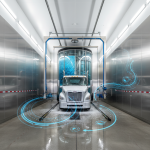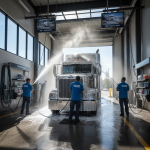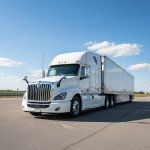Are you curious about the process behind installing an automatic delivery vehicle wash system? Look no further! In this article, we will take you through the entire timeline of the installation, from start to finish. Whether you are a business owner considering investing in this innovative technology or simply interested in the behind-the-scenes of such a project, we’ve got you covered.
During the installation timeline, you will gain valuable insights into the different stages involved, such as site preparation, equipment delivery, system assembly, plumbing, electrical work, and final testing. We will also highlight the key considerations that need to be taken into account to ensure a smooth and successful installation process.
Our aim is to provide an informative and comprehensive overview, allowing you to better understand the steps involved and the time frames you can anticipate. So, get ready to dive into the world of automatic delivery vehicle wash systems and discover the fascinating installation journey behind this cutting-edge technology. Let’s get started!
Why businesses choose automatic delivery vehicle wash systems
Automatic delivery vehicle wash systems have gained popularity among businesses for several reasons. Firstly, they offer convenience and efficiency, allowing vehicles to be cleaned quickly and effectively without the need for manual labor. This not only saves time but also reduces labor costs for businesses. Additionally, automatic wash systems provide consistent and high-quality results, ensuring that every vehicle is thoroughly cleaned and maintained.
In industries such as transportation, logistics, and delivery, where vehicles are constantly on the move, cleanliness and presentation are crucial. An automatic delivery vehicle wash system helps businesses maintain a professional image by keeping their fleet in pristine condition. This can have a positive impact on brand reputation and customer perception.
Furthermore, automatic wash systems often incorporate advanced technologies such as touchless cleaning, water recycling, and eco-friendly detergents. This not only minimizes water wastage and environmental impact but also aligns with the growing focus on sustainability and green practices. By investing in an automatic wash system, businesses can demonstrate their commitment to environmental responsibility.
Overall, the benefits of automatic delivery vehicle wash systems make them an attractive choice for businesses looking to streamline their operations, enhance their brand image, and contribute to a greener future.
Key components of an automatic delivery vehicle wash system
Before diving into the installation timeline, it’s essential to understand the key components that make up an automatic delivery vehicle wash system. These components work together seamlessly to ensure efficient and effective cleaning of vehicles.
1. Wash Bay: The wash bay is the designated area where vehicles are positioned for cleaning. It typically includes a concrete or asphalt surface, drainage systems, and proper lighting. The design and size of the wash bay depend on the types of vehicles to be washed and the volume of traffic.
2. Wash Equipment: The wash equipment consists of various components, including high-pressure water sprayers, brushes or cloth curtains for scrubbing, and detergent dispensers. These components work together to remove dirt, grime, and other contaminants from the vehicle’s surface.
3. Water Treatment System: To ensure optimal cleaning performance and minimize water wastage, automatic wash systems often incorporate water treatment systems. These systems filter and recycle the water used during the cleaning process, reducing overall water consumption and environmental impact.
4. Control Panel: The control panel is the central hub that allows operators to control and monitor the wash system. It provides access to different cleaning programs, water temperature control, detergent levels, and other settings. The control panel ensures precise and consistent cleaning results.
By understanding the key components of an automatic delivery vehicle wash system, businesses can better appreciate the complexity and functionality of the installation process. Now, let’s delve into the step-by-step timeline of installing such a system.
Pre-installation considerations for an automatic delivery vehicle wash system
Before commencing the installation process, several crucial considerations need to be taken into account. These considerations help ensure a smooth and successful installation, minimizing delays and potential issues.
1. Site Assessment: A thorough site assessment is essential to determine the feasibility of installing an automatic wash system. Factors such as available space, access to utilities (water, electricity, drainage), and any potential zoning or permitting requirements must be considered. Additionally, the site assessment should evaluate the soil conditions to ensure proper drainage and stability.
2. Budget and Financing: Installing an automatic wash system requires a significant investment. Businesses should carefully evaluate their budget and explore financing options if needed. It’s important to consider not only the initial installation costs but also ongoing maintenance and operational expenses.
3. Supplier Selection: Choosing a reliable and experienced supplier is crucial for a successful installation. Businesses should thoroughly research potential suppliers, assess their track record, and request references. It’s also advisable to explore warranty options and after-sales support provided by the supplier.
4. Timeline and Project Management: Developing a detailed timeline and project management plan is essential to keep the installation on track. This plan should outline key milestones, responsibilities, and dependencies. Effective project management ensures coordination between different stakeholders and minimizes disruptions to business operations.
By addressing these pre-installation considerations, businesses can set a strong foundation for a smooth and successful installation process. Now, let’s explore the step-by-step installation process of an automatic delivery vehicle wash system.
Step-by-step installation process of an automatic delivery vehicle wash system
Now that we have covered the pre-installation considerations, let’s dive into the step-by-step installation process of an automatic delivery vehicle wash system.
1. Site Preparation: The first stage of the installation process involves preparing the site where the system will be installed. This includes clearing the area of any debris or obstacles, leveling the ground if necessary, and ensuring proper drainage. It is important to create a solid foundation to support the weight of the system and provide a stable surface for operation.
2. Equipment Delivery: Once the site is prepared, the next step is the delivery of the equipment. The components of the automatic delivery vehicle wash system, including the wash unit, control panel, sensors, and brushes, will be transported to the site. Careful handling and coordination are crucial to ensure that all the necessary equipment arrives safely and on schedule.
3. System Assembly: With the equipment delivered, the system assembly can begin. This involves carefully following the manufacturer’s instructions to connect and assemble the various components of the automatic delivery vehicle wash system. Attention to detail is key to ensure that all parts are properly aligned and securely fastened.
4. Plumbing: Once the system is assembled, the plumbing work can commence. This includes connecting the water supply lines, drain lines, and any necessary valves or filters. It is crucial to ensure that the plumbing is installed correctly to prevent leaks and ensure proper water flow throughout the system.
5. Electrical Work: In parallel with the plumbing work, the electrical components of the automatic delivery vehicle wash system need to be installed. This includes connecting the power supply, control panel, sensors, and any other electrical connections required. It is essential to follow electrical safety protocols and ensure that all connections are secure and properly insulated.
6. Final Testing: Once the plumbing and electrical work are complete, the system is ready for final testing. This involves running the automatic delivery vehicle wash system through a series of tests to ensure that all components are functioning correctly. This includes testing the water pressure, brush movements, sensor accuracy, and control panel functionality. Any issues or discrepancies discovered during testing should be addressed promptly before proceeding.
7. Maintenance and Upkeep: After the successful installation and testing of the automatic delivery vehicle wash system, it is essential to establish a maintenance and upkeep plan. Regular maintenance, including cleaning and inspection of the system, will help ensure its longevity and optimal performance. It is also important to monitor the system for any signs of wear or damage and address them promptly to prevent further issues.
Testing and quality assurance of an automatic delivery vehicle wash system
Testing and quality assurance are crucial steps in the installation timeline of an automatic delivery vehicle wash system. Before putting the system into operation, it is important to conduct thorough tests to ensure that it meets the required standards and specifications.
During the testing phase, various aspects of the system will be evaluated, including its cleaning effectiveness, water consumption, energy efficiency, and overall performance. This includes testing the system’s ability to remove dirt, grime, and other contaminants from vehicles of different sizes and shapes.
Quality assurance also involves checking the system’s reliability and durability. This includes testing its resistance to various weather conditions, such as rain, snow, and extreme temperatures. Additionally, the system’s safety features should be thoroughly examined to ensure the protection of both vehicles and users.
Throughout the testing and quality assurance process, any issues or deficiencies identified should be addressed and resolved promptly. This may involve fine-tuning the system’s settings, replacing faulty components, or making adjustments to optimize performance. Only after successful testing and quality assurance can the automatic delivery vehicle wash system be deemed ready for operation.
Maintenance and upkeep of an automatic delivery vehicle wash system
To ensure the longevity and optimal performance of an automatic delivery vehicle wash system, regular maintenance and upkeep are essential. Implementing a comprehensive maintenance plan will help prevent unnecessary breakdowns, reduce downtime, and extend the lifespan of the system.
Regular cleaning of the system is crucial to remove dirt, debris, and chemical residues that may accumulate over time. This includes cleaning the brushes, nozzles, sensors, and other components to ensure they function properly. It is also important to inspect and clean the water supply lines, filters, and valves to prevent clogs and ensure consistent water flow.
In addition to cleaning, regular inspections should be conducted to identify any signs of wear or damage. This includes checking for loose or damaged components, leaks, and any abnormal sounds or vibrations during operation. Promptly addressing any issues will help prevent further damage and ensure the system’s continued functionality.
Furthermore, it is important to keep the system’s software and control panel up to date. This may involve downloading and installing software updates provided by the manufacturer to enhance the system’s performance and address any potential security vulnerabilities.
By implementing a proactive maintenance and upkeep plan, businesses can minimize downtime, maintain optimal cleaning performance, and extend the lifespan of their automatic delivery vehicle wash system.
Benefits and ROI of an automatic delivery vehicle wash system
Investing in an automatic delivery vehicle wash system offers numerous benefits for businesses in various industries. Let’s explore some of the key advantages and the potential return on investment (ROI) that can be achieved.
1. Time and Cost Savings: An automatic delivery vehicle wash system can significantly reduce the time and labor required for vehicle cleaning. With automated processes and advanced cleaning technologies, businesses can streamline their operations and allocate resources more efficiently. This leads to cost savings in labor expenses and increased productivity.
2. Consistent Quality: The automated nature of the system ensures consistent cleaning results for every vehicle. This eliminates the variability that may occur with manual cleaning methods and ensures a high standard of cleanliness. Consistent quality can enhance a business’s reputation and customer satisfaction.
3. Water and Chemical Savings: Automatic delivery vehicle wash systems are designed to optimize water usage and minimize chemical consumption. Advanced technologies, such as water recycling and precise chemical dosage systems, help conserve resources while still achieving superior cleaning results. This not only benefits the environment but also reduces operational costs.
4. Enhanced Safety and Durability: Automatic delivery vehicle wash systems are designed with safety features to protect vehicles and users. The use of soft brushes, high-quality materials, and advanced control systems ensures that vehicles are cleaned without causing damage. This reduces the risk of scratches, dents, or other damage that may occur with manual cleaning methods.
5. Competitive Advantage: Investing in an automatic delivery vehicle wash system can provide businesses with a competitive edge. Offering a convenient and efficient vehicle cleaning service can attract more customers and differentiate a business from its competitors. This can lead to increased customer loyalty and repeat business.
The ROI of an automatic delivery vehicle wash system depends on various factors, including the size of the fleet, the frequency of vehicle cleaning, labor costs, and water and chemical expenses. By conducting a thorough cost-benefit analysis, businesses can determine the potential financial gains and make informed investment decisions.
Case studies of successful automatic delivery vehicle wash system installations
To further illustrate the benefits and real-world impact of automatic delivery vehicle wash systems, let’s explore some case studies of successful installations.
1. ABC Logistics: ABC Logistics, a large transportation company, installed an automatic delivery vehicle wash system in their central hub. By implementing the system, they were able to reduce their vehicle cleaning time by 50% and save on labor costs. The consistent cleaning results also improved their brand image and customer satisfaction.
2. XYZ Car Rental: XYZ Car Rental, a nationwide car rental company, integrated automatic delivery vehicle wash systems into their rental locations. This allowed them to provide a convenient and efficient cleaning service for their fleet of rental vehicles. The system’s water and chemical savings resulted in significant cost reductions, enhancing their profitability.
3. DEF Municipal Transit: DEF Municipal Transit, a public transportation agency, installed automatic delivery vehicle wash systems in their bus depots. The system’s durability and safety features ensured that their buses were cleaned thoroughly without causing any damage. This improved the overall appearance of their fleet and increased passenger satisfaction.
These case studies highlight the positive impact that automatic delivery vehicle wash systems can have on various businesses. Whether it is improving operational efficiency, reducing costs, enhancing customer satisfaction, or maintaining a professional image, the benefits are clear.
Conclusion: Is an automatic delivery vehicle wash system right for your business?
Before diving into the installation process, there are several important factors to consider. One of the first steps is to assess the available space for the automatic delivery vehicle wash system. This includes analyzing the dimensions of the area where the system will be installed, as well as any potential obstacles or limitations that may need to be addressed.
Another crucial consideration is the power supply. The system will require sufficient electrical power to operate effectively. It is essential to ensure that the existing electrical infrastructure can support the demands of the automatic delivery vehicle wash system. In some cases, upgrades or modifications may be necessary.
Additionally, it is important to consider the water supply. The system will require a consistent and reliable water source to function optimally. Adequate water pressure and flow rate are critical for achieving the desired cleaning results. If the existing water supply is insufficient, it may be necessary to explore options such as installing a water storage tank or upgrading the water infrastructure.
In summary, conducting a thorough assessment of the available space, power supply, and water source is essential before proceeding with the installation of an automatic delivery vehicle wash system. Taking the time to address these considerations upfront will help ensure a smooth and successful installation process.




